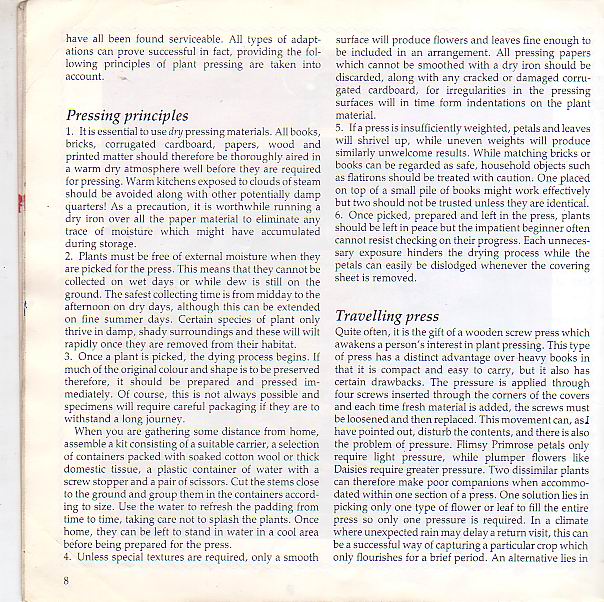749849337958684474

have all been found serviceable. AU types of adapt-alions can prove successful in fact, prnviding the fol-lowing principles of piani pressing ani taken i.nto accounl.
Pressing principles
1. Itisessential to usedn/pressing ma terials. A!! books, bricks, corrugaled cardboard, pupers, wood and prinlcd matter should thereforebe thoroughly a i red in a warm dry atmnsphere well before they aa' required for pressing. Warm kitchens exposcd to douds of steam should be avoiried along willi other polenlially Uarnp quartcrs! As a precaution, it is worthwhile running a dry iron over all the paper materiał to eliminate any tracę of rnoisturc which might havc accumulated during storagp.
2. PlantS nuist be free o: cxtcmal ino:storę when they are pirked for the press. This means chat they cannot be collected on wet days or while dew is s|j|| on lite ground. The safest coliecting time :s from midday to :he aftemoon on dry days, although this can be extended on fine summer days. Certain spcdes of plant only thrive in damp, shady surroundings and these will will rapidly once they are remoeed from their habitat.
3. Once a plant is pirked, the dying process begjns. I: much of the original colour and shapc is to be presereed therefbre, it should be prepared and pressed im-medialely. Of coursc, this is not always possiblc and spęd mc ns will rcquire careful packaging if they are to withstand a long joumey.
When you are gnthcring some distance from Home, assemble a kit consisting of a suitable carrier, a seleetion of coniainers packed with soaked cotton wool or thick domestic tissue, a plastic Container of watcr with a screw stopper and a pairof scissors. Cu* thestemsclose to the ground and group them in the coniainers accord-ing to size. L'se :he water :o refresh the padding !rom time to time, taking carc not to splasli the plants. Once norne. they ran be left to stand in water in a cool area before being prepared for the press.
4. Unless specia! textures are required, only a smooth surfa ce will produce flowers and ieaves fłnc enough tu be included in an anangement. All pressing papers which cannot be smoothed with a dry iron should be discarded, alung with any rracked or damaged corru-gated cardboard, tor irregularities in the pressing surfaces will in time form indenlations on the plant materiał.
5. If a press is insufficienily weighted, petals andlcavcs will shrivel up. whilc uneven weighrs will produce similarly unweloome resulls. While matching bricks or books can be regarded as safe, Household objects such as flatirons should be treated with caution. One placed on top of a smali pile of books might work effectivelv but two should not be trusted unless they aro identical.
6. Once picked, prepared and luft :n the press, plants should be left in peace but the impatienł beginneroften cannot resist checkingon their progress. Each unneces-sary exposure hinders the drying process while the pelals can easily be dislodged whenever the covering sheet is removed.
Travelling press
Quite often, it is the gift of a wooden screw press which awakcns a person's interest in plant pressing. This type of press nas a distinct advantage over heavy books in that it is compact and easy to carry, but it also has certain drawbacks. The pressure is applied through four SCrews inserted through the corners of the covcrs and each time fresh materiał is audcd, the screws must be loosened and then replaced. This movemenlcan, asJ have pointed out, disturb the ContentS, and there isalso the problem of pressure. Flimsy Primrose pelals only require light pressure, wllile plutnper flowers like Daisies rcquire greater pressure. Two dissimiłar plants can there lorę make poor companions when accommo-dated within one section of a press. One solution lies in picking only one type of flowcr or leaf to fili the entire press so only one pressure is required. In a dimate where unexpected rain may delay a return visir, tiiis can bea successful way of capluring a particularcrop which only flourishes for a brief period. An alternaiive lies in
Wyszukiwarka
Podobne podstrony:
have all been found serviceable Ali typcs of adapt-ations can prcmr successful in fact, prmńding the
skanuj0001 Self-Assessment Moauie i A There are and always have been as many different types of musi
skanuj0001 Self-Assessment Module o A There are and always have been as many different types of musi
156 Australia A thłrd of all foundatlon investlgators perform other types of ponetratlon tesls (desc
society posesses less and less of a »socialist consciousness«, and that it, in fact, even refuses to
What are the three types of rocks?•Vo.can,c^^ęks •Form when magma or lava cools
S5006663 The earliest types of eastem-Celtic glass omamentsMaciej Karwowski Artefacts dated to the s
363 (17) 336Bells Two types of bells were wom as accessories in medieval England: rumbler bells, whi
attorney-in-fact, including the natural person acting on behalf of the attorney-in-fact which is a l
screenshot 6 XTwitter Via@ Opt-out of tailoring Twitter
screenshot 2 BUTTON OPTIONSTwitter Via@ Opt-out of tailoring Twitter
screenshot 6 XTwitter Via@ Opt-out of tailoring Twitter
Slide4 KNOWIT See the information from side two of your cards (Polish) and write in your workbook&nb
166 C&t&lina Yelculescu, V. Gtiruianu H In fact, by the end of the 18th century and the
Entrelac Patterns This child s sweater can be worked in any size. The diagram shows the differe
1.2. Goal and Plan of the Work 3 It is assumed that the goal of this work can be reached in the foll
więcej podobnych podstron